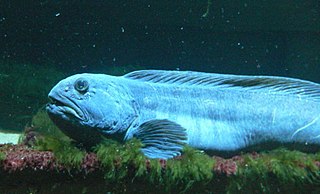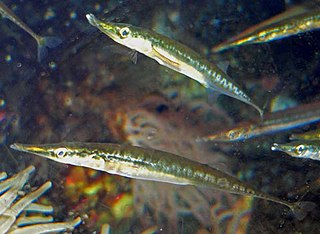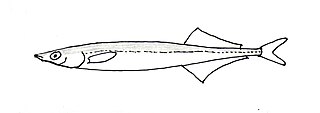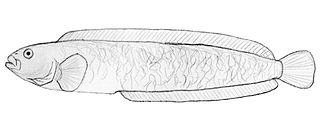
Ronquils is a small family marine ray-finned fish, the Bathymasteridae. These fishes are found only in Arctic and North Pacific waters. This family contains just seven species in three genera. The larger species are important to commercial fisheries as food fish. Ronquils are most closely related to the eelpouts and prowfish in the suborder Zoarcoidei of the order Scorpaeniformes.

Anoplopomatidae, the sablefishes, are a small family of ray-finned fishes classified within the order Scorpaeniformes. This family is the only family in the monotypic superfamily Anoplopomatoidea. These fishes are found in the North Pacific Ocean.

Rhamphocottidae is a family of ray-finned fishes belonging to the superfamily Cottoidea, the sculpins. The species in this family occur in the North Pacific Ocean.
Zoarces is a genus of marine ray-finned fishes belonging to the family Zoarcidae, the eelpouts. It is the only genus in the subfamily Zoarcinae. These eelpouts are found in the northern Atlantic and northern Pacific Oceans.

Hexagrammidae, the greenlings, is a family of marine ray-finned fishes belonging to the suborder Cottoidei in the order Scorpaeniformes. These fishes are found in the North Pacific Ocean.

Anarhichadidae, the wolffishes, sea wolves or wolf eels, is a family of marine ray finned fishes belonging to the order Scorpaeniformes. These are predatory, eel shaped fishes which are native to the cold waters of the Arctic, North Pacific and North Atlantic Oceans.

Pholidae is a family of marine ray-finned fishes, known as gunnels, in the scorpaeniform suborder Zoarcoidei. These are fishes of the littoral zone and are mainly found in North Pacific Ocean, with two species found in the North Atlantic Ocean and Arctic Ocean.

Stichaeidae, the pricklebacks or shannies, are a family of marine ray-finned fishes in the suborder Zoarcoidei of the order Scorpaeniformes. Most species are found in the North Pacific Ocean with a few in the North Atlantic Ocean.

The stripedfin ronquil, also known as the bluebanded ronquil, is a species of marine ray-finned fish belonging to the family Bathymasteridae, the ronquils. This fish is found in the eastern Pacific Ocean.

The Trichodontidae, or sandfishes, are a small family of ray-finned fishes from the order Scorpaeniformes. The species in this family are found in the North Pacific Ocean.

Zoarcoidei is a suborder of marine ray-finned fishes belonging to the order Scorpaeniformes. The suborder includes the wolffishes, gunnels and eelpouts. The suborder includes about 400 species. These fishes predominantly found in the boreal seas of the northern hemisphere but they have colonised the southern hemisphere.

Anarhichas is a genus of marine ray-finned fishes belonging to the family Anarhichadidae, the wolffishes or sea wolves. These fishes are found in the northern North Atlantic and North Pacific oceans.

Aulorhynchidae, the tube-snouts, is a small family of marine ray-finned fishes belonging to the suborder Gasterosteoidei in the order Scorpaeniformes. These fishes are found in the northern Pacific Ocean.

The Korean sandlance is a species of marine ray-finned fish belonging to the family Hypoptychidae. The Korean sandlance is the only species in this monotypic family and genus and is found in the northwestern Pacific Ocean.

The Zaniolepididae is a family of marine ray-finned fishes classified within the suborder Cottoidei of the order Scorpaeniformes. They are found in the North Pacific Ocean.

Cryptacanthodes is a genus of is a genus of marine ray-finned fishes belonging to the monogeneric family Cryptacanthodidae, commonly referred to as wrymouths. Three of the four species are found in the Pacific Ocean with one species native to the western Atlantic Ocean where they are benthic fishes, tunneling through soft substrates. It is currently the only known genus in its family.

Easchmeyer nexus is a species of marine ray-finned fish; it is the only species in the monotypic genus Eschmeyer and monogeneric family Eschmeyeridae. This fish is only known from the Pacific Ocean, near Fiji.

The rockweed gunnel, also known as the Fucus blenny, is a species of marine ray-finned fish belonging to the family Pholidae, the gunnels. This species is found in the eastern North Pacific Ocean.

Opisthocentrinae is a subfamily of marine ray-finned fishes, classified within the family Stichaeidae, the pricklebacks or shannies. These fishes are found in the North Pacific Ocean.

Pholidapus is a monotypic genus of marine ray-finned fishes belonging to the family Stichaeidae, the pricklebacks and shannies. Its only species is Pholidapus dybowskii which is found in the northwestern Pacific Ocean.


















